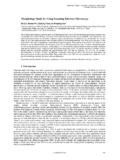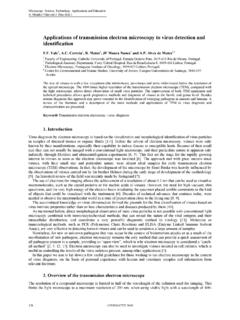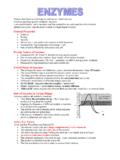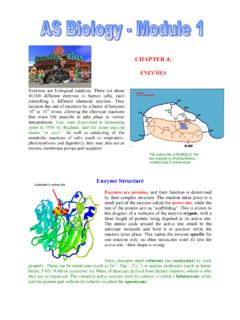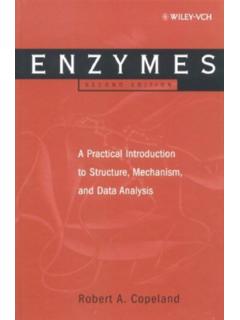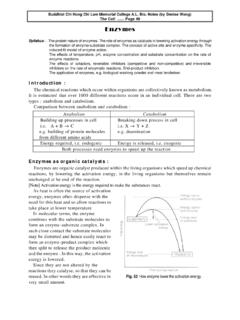Transcription of Nitroreductases: Enzymes with Environmental ...
1 nitroreductases : Enzymes with Environmental , biotechnological and clinical importance Iuri Marques de Oliveira1, Diego Bonatto1,2 and Jo o Antonio P gas Henriques*1,2 1 Centro de Biotecnologia, Universidade Federal do Rio Grande do Sul (UFRGS), Av. Bento Gon alves 9500, 91507-970 Porto Alegre, RS, Brazil 2 Instituto de Biotecnologia, Universidade de Caxias do Sul (UCS), Rua Francisco Get lio Vargas 1130, Bloco 57, 95070-560 Caxias do Sul, RS, Brazil. *Corresponding author: e-mail: p Telephone: 55-51-3308-7602; Fax: 55-51-3308-6084 The nitroreductase family comprises a group of flavin mononucleotide (FMN)- or flavin adenine dinucleotide (FAD) -dependent Enzymes that are able to metabolize nitroaromatic and nitroheterocyclic derivatives (nitrosubstituted compounds) using the reducing power of nicotinamide adenine dinucleotide (NAD(P)H).
2 These Enzymes can be found in bacterial species and, to a lesser extent, in eukaryotes. The nitroreductase proteins play a central role in the activation of nitrocompounds and have received a lot of attention in recent decades based on their (a) Environmental and human health importance due to their central role in mediating nitrosubstituted compound toxicity; (b) biotechnological application for bioremediation biocatalysis; and (c) clinical importance in chemotherapeutic tumor treatment, ablation of specific cells and antibiotic resistance. Nitrosubstituted compounds are mainly produced by industrial processes or other human activities and have become an important group of Environmental pollutants.
3 Human health concerns have arisen with regard to these compounds because their metabolization leads to the formation of potent genotoxic and mutagenic metabolites and to the generation of reactive nitrogen oxide species, which readily react with biological macromolecules. In addition, many genotoxic tests have been performed using mutant strains of bacteria such as Salmonella typhimurium that do not express or overexpress these Enzymes , to identify and elucidate the molecular mechanism of mutagenesis caused by several nitrocompounds. Bioremediation treatments for nitroaromatic and nitroheterocyclic compounds, in particular phytoremediation using transgenic plants expressing bacterial nitroreductases or soil bacteria such as Bacillus sp.
4 , may be effective in decontaminating soil in situ. The nitroreductases have clinical application due to their ability to convert non-toxic prodrugs such as CB1954 (5-[aziridin-1-yl]-2,4-dinitrobenzamide) into a potent DNA-crosslinking cytotoxic agent that kills tumor cells. These Enzymes have great clinical interest because they are used in techniques such as gene (or virus) directed enzyme prodrug therapy (GDEPT or VDEPT) and antibody-directed enzyme prodrug therapy (ADEPT) for potential use in the treatment of certain tumors. nitroreductases are also involved in resistance to metronidazole, a drug used mainly in infections caused by Helicobacter pylori, which causes gastric ulcers and constitutes a risk factor for adenocarcinoma and gastric lymphoma.
5 In this chapter, the most relevant aspects of nitroreductases Enzymes are presented and discussed: the occurrence of these Enzymes in organisms, their catalytic reduction mechanism, physiological role and importance in mediating the toxicity of nitrocompounds, and their influence on the environment and human health, as well as their potential biotechnological and medical applications. Keywords nitroreductases , nitrocompounds; bioremediation; cancer therapy 1. Introduction: Nitrocompounds and nitroreductases Nitrocompounds such as nitroaromatic and nitroheterocyclic derivatives (nitrosubstituted compounds) constitute a large group of chemicals that are characterized by the presence of one or more nitro groups [1].
6 The toxic effects of nitrosubstituted aromatics have been well-established, and many of these compounds have been reported as toxic, mutagenic, or carcinogenic [2]. However, nitroaromatic compounds, including nitrofurans, nitropyrenes, nitrobenzenes and several others, have been used in multiple applications as pharmaceuticals, antimicrobial agents, food additives, pesticides, explosives, dyes and raw materials in several industrial processes. As a result, they are distributed widely in the environment and are categorized as an important group of pollutants [3, 4]. Enzymatic reduction is essential for the nitrocompounds to exercise their therapeutic and/or cytotoxic effects, and most nitroaromatics should undergo enzymatic reduction in organisms [1, 5].
7 The nitroreductases proteins form a group of Enzymes that have a central role in the reduction of nitro groups on nitrocompounds [5]. nitroreductases comprise a family of proteins with conserved sequences that were originally discovered in eubacteria and have been grouped together based on their sequence similarity [6]. These Enzymes are capable of catalyzing the reduction of nitrosubstituted compounds using flavin mononucleotide (FMN) or flavin adenine dinucleotide (FAD) as prosthetic groups and nicotinamide adenine dinucleotide (NADH) or nicotinamide adenine dinucleotide phosphate (NADPH) as reducing agents [5, 6]. These proteins have recently raised enormous interest both in the Environmental engineering community (due to their central role in mediating nitroaromatic toxicity and their potential use in bioremediation and biocatalysis) and in the medical community (as agents used to activate prodrugs in directed anticancer therapies).
8 In addition, many studies have associated nitroreductases with susceptibility to antibiotics [7, 8]. Therefore, in this chapter will discuss the importance of nitroreductase in the environment and human health by _____ mediating the toxicity of nitro, biotechnology in bioremediation, removal of cell populations and clinical resistance to antibiotics and treatment of tumors as well as their occurrence and possible physiological functions. 2. Where nitroreductases are and how they work In the nitro group, the bond between the oxygen and nitrogen atoms is polar because oxygen is more electronegative than nitrogen, attracting nitrogen s electrons to form partially negative and positive poles.
9 The positive pole tends to attract electrons, and therefore, it has a great tendency to undergo reduction [3]. The reduction of nitro groups can be catalyzed by nitroreductase Enzymes that can perform one" or two"electron transfers [5, 6]. Thus, the nitroreductases have been grouped into two categories based on their ability to reduce nitro groups in the presence of oxygen by one"electron or two"electron transfers (Figure 1): (i) Type I (oxygen"insensitive) nitroreductases catalyze the sequential transfer of two electrons from NAD(P)H to the nitro groups of nitrosubstituted compounds, in the presence or absence of oxygen, resulting in nitroso and hydroxylamine intermediates and finally primary amines.
10 In general, type I nitroreductases perform two"electron transfers using a ping pong, bi bi kinetic mechanism, and the FMN group cycles between the oxidized and the reduced states with a flavin two"electron reduction [5, 6]. The formation of the hydroxylamino intermediate is well"established, because it has been detected in numerous studies of nitro group reduction. However, because the nitroso intermediate is so reactive and the second two"electron reaction has a much faster rate than the first two"electron transfer, it is difficult to isolate. However, its role can be inferred from studies of nitrocompounds that are reduced in controlled chemical reactions [3, 6]. (ii) Type II (oxygen"sensitive) nitroreductases catalyze one"electron reductions of the nitro group in the presence of oxygen, producing a nitro anion radical that subsequently reacts with molecular oxygen, forming a superoxide radical and regenerating the original nitroaromatic compound.
